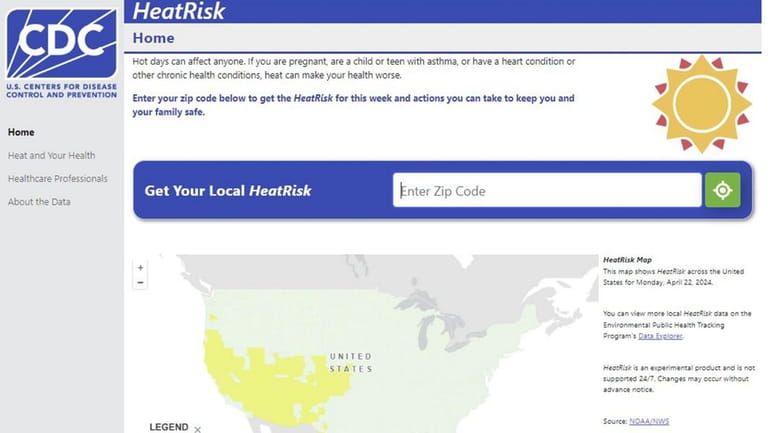Forecasting extreme heat and its health risks offered in new online tracker amid global warming

CDC’s HeatRisk Dashboard, a consumer-friendly product, integrates the HeatRisk Forecast Tool data with other information, including details on local air quality, to inform the public on how best to protect themselves when outdoor temperatures are high and could impact their health. Credit: CDC/NWS
Tracking extreme heat and understanding its health risks will be easier this summer with new experimental online tools unveiled Monday by two federal agencies.
The HeatRisk Forecast Tool, developed by the Centers for Disease Control and Prevention along with the National Oceanic and Atmospheric Administration (NOAA) provides a seven-day heat forecast, with color-coded categories that outline the health dangers associated with hot weather. The HeatRisk Dashboard pairs the heat forecast with local air quality and other information, such as how to protect yourself.
Summer 2023 was the hottest across the globe since at least 1880, according to NASA. In the U.S., more than two-thirds of the population experienced a health alert due to high heat and smoke from Canadian wildfires triggered several air quality alerts on Long Island and the Northeast.
As scientists predict that climate change will continue to produce record-breaking temperatures, guides like the one produced by the CDC and the weather service will become increasingly vital, officials said.
“Heat is a threat to our health,” said Dr. Mandy Cohen, CDC director, during a Monday news conference. “Heat can be especially dangerous for certain people, including very young kids, kids with asthma, older adults, pregnant moms and people with underlying health conditions like heart disease.”
Cohen said the agency is also encouraging clinicians to evaluate their patients for risk of heat-related illness even before the summer heat by asking if they have air conditioners or access to cooling centers, friends or neighbors who can check in on them and if they take medication that might impact their risk to heat exposure.
Heat related illness led to over 120,000 emergency department visits last year, she said.
“Extreme heat kills more people in the U.S. today than any other weather hazard,” said NOAA Administrator Richard Spinrad. “That includes hurricanes, floods and tornadoes.”
The heat categories in the guide run from green, which means there is little to no risk from expected heat, to yellow, orange, red and magenta, which marks extreme heat.
For example, a heat category at level red would impact anyone who didn't have effective cooling or hydration while the heat at level yellow generally only affects those who are very sensitive to heat and dehydration.
Having an online tool that lets people look at an extended forecast and see how temperatures could affect health in an easy-to-use format is important, said Kevin Reed, a professor in the School of Marine and Atmospheric Sciences at Stony Brook University.
“I think, eventually, it would be useful to have one site with even more data, such as forecasts of extreme precipitation and flooding,” Reed said. “We have seen on Long Island and in New York City when LIRR underpasses and subways flood and this would be a way to better prepare for that.”
A recent CDC report determined that emergency department visits “substantially increased” between May and September 2023 in several regions of the U.S. when compared to 2018-2022. The rise was notable among men and adults between the ages of 18 and 64.
Garbage truck driver indicted ... Credit card fees ... New housing in East Farmingdale ... What on earth is a crookie?
Garbage truck driver indicted ... Credit card fees ... New housing in East Farmingdale ... What on earth is a crookie?

